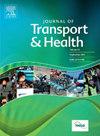Impacts of a community-wide infrastructural intervention on children's active school travel: A controlled before-after study
IF 3.3
3区 工程技术
Q2 PUBLIC, ENVIRONMENTAL & OCCUPATIONAL HEALTH
引用次数: 0
Abstract
Background
Active school travel (AST) is beneficial for children's physical, social, and mental well-being. However, AST is low globally, and Aotearoa New Zealand has one of the lowest rates of AST worldwide. Te Ara Mua – Future Streets (TAMFS) was a randomised controlled before-after study of neighbourhood-wide infrastructural changes to make it easier for residents to get around actively. The intervention was conducted in Ngā Hau Māngere, in Aotearoa New Zealand. This study examines the impact of TAMFS on children's AST over time.
Methods
Data for the current study were gathered from resident surveys, conducted at baseline (2014), early follow-up (2017), and long-term follow-ups (2021, 2023). The primary outcome for this study was the proportion of children using AST, analysed using mixed model logistic regression and difference-in-differences (DID) analysis. Coding of open-ended responses to the main reason for children's travel mode to school was also undertaken.
Results
AST rates declined in both intervention and control areas over time, with a significant drop in the intervention area immediately post-intervention (2017). By 2023, the difference between areas was minimal. Living close to school was the main reason for getting to school actively, while a mix of distance (longer), convenience, and safety concerns were key decisionmakers for parents of passive travellers.
Conclusion
While environmental changes are important, future interventions would benefit from considering broader contextual factors and integrating community engagement and programming to address barriers to AST and support shifts to active transport modes.
社区基础设施干预对儿童主动上学旅行的影响:一项前后对照研究
积极的学校旅行(AST)对儿童的身体、社会和心理健康有益。然而,AST在全球范围内较低,新西兰的Aotearoa是全球AST发病率最低的国家之一。the Ara Mua - Future Streets (TAMFS)是一项随机控制的前后研究,旨在研究社区范围内的基础设施变化,使居民更容易活跃地四处走动。干预措施在新西兰奥特罗阿的nghau Māngere进行。本研究考察了TAMFS对儿童AST的长期影响。方法本研究的数据收集自居民调查,分别在基线(2014年)、早期随访(2017年)和长期随访(2021年、2023年)进行。本研究的主要结局是使用AST的儿童比例,使用混合模型逻辑回归和差异中差(DID)分析进行分析。对儿童上学出行方式的主要原因进行开放式回答编码。结果随着时间的推移,干预区和对照组的ast发生率均有所下降,干预区在干预后立即出现显著下降(2017年)。到2023年,地区之间的差异微乎其微。住得离学校近是主动上学的主要原因,而距离(更长)、便利和安全问题是被动出行父母的主要决策因素。虽然环境变化很重要,但未来的干预措施将受益于考虑更广泛的背景因素,并整合社区参与和规划,以解决AST的障碍,并支持向主动运输模式的转变。
本文章由计算机程序翻译,如有差异,请以英文原文为准。
求助全文
约1分钟内获得全文
求助全文

 求助内容:
求助内容: 应助结果提醒方式:
应助结果提醒方式:


